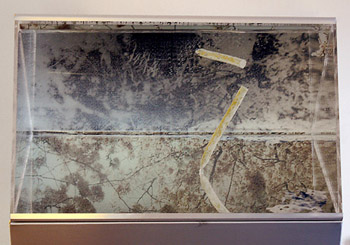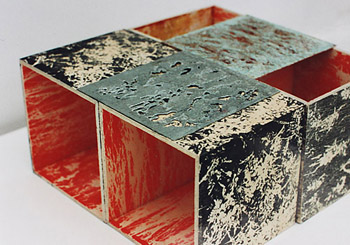PROJECTS
Layers of remembrance

2009
Some transparencies of my archive were photographed over a light table. These membranes, which were used as the first materials for prints, had all been exposed and developed in the dark room and then transferred on zinc plates or silkscreen frames, so as to become prints in the end. Recollecting them over a light table created for me a new opening for the understanding my past work and allowed me to experience the fragile nature of images as memories. My archive has released its force through recaptures of different accidental arrangements. It is somehow "a book of fragments of memories", were the personal and the historical/collective are blending in new patterns. As one transparency illustrates the other, layer over layer, concealing their initial function and meaning, there is a chance to observe that moment in the creative process when different elements of personal, collective or visual history tend to overlap and delete their own origins.
Reflection box

1997
Athens art fair
This work is about the meeting point of contents that merge creating common grounds in a plane surface just for a glimpse. Then they depart to what they were before they met leaving behind them a charged void, an absence full of the aura of their union. In this case one surface is a container made of grass images, a container that may be viewed as text generator, a text outside the familiar context of the language. In nature, the ever‐present repetitive patterns can be read as a possible narrative sequence of no apparent meaning. There seems to be repetition just for the sake of it, a lack of specific purpose which remains indecipherable.
Presenting here natural patterns as text that when changing our positions as viewers reflect on flowers surfaces is a means to demonstrate the limits of human rationality as such, especially when confronted with schemes that may appear trivial and insignificant but are in fact larger than rationality itself and therefore beyond its capacity of understanding. Like some child‐like nonsense song that is pleasant but completely pointless or, when observed more closely, even unsettling and uncanny, precisely because of its meticulous purposelessness.
War and peace

1999
Ileana Tounta
In this group of works, photographs of WWII sea battles have been processed, with all the images of battleships digitally erased and replaced with almond blossoms. The momentary and devastating bang of the original explosions has been turned into a blooming explosion of flowers – slow, tranquil and fragile but still transformative, a true celebration of life. It is customary to offer flowers to honor the lost and to welcome the new. The paradox of these images illustrates both the inevitable battlegrounds our inner conflicts and the natural process of healing that, if we allow it, always comes after any disaster or trauma we have managed to survive from, be it personal or collective. Transformed through time and memory, the scars of any sort of war may heal and bloom, so as to finally become an actual source of new life and lasting peace.
Readable embroideries

Women of the Mediterranean Sea, 1997
Exhibition organized by UNESCO, Thessaloniki-Cultural Capital of Europe
Through the long centuries during which women have been forced into an endless social and creative silence, reading and embroidery have been two of the few acceptable pastimes for them. Patiently following the repeated patterns of embroidery and the repeated signs in the books, they had been narrating their own silent story to themselves and forgetting its reality at the same time. They were reminiscing but not remembering their own creative powers and just had to settle for a semblance of an identity instead of the truth about themselves. I have attempted here a reappropriation of embroidery as a silent, hand-crafted text. The golden parts of this work were made of gold thread. The bodies of the women have been embroidered, as well as the books they read. Embroidery here is not meant to be merely decorative; it is about trusting and choosing patterns and signs outside oneself, making them a part of a personal practice and expression.
Cybele's long travel in time

The cube, as a geometrical solid, was linked to the goddess Cybele, after whom it has been named. Cybele was an earth goddess of Phrygian origin, worshiped in ancient Greece and Rome as a protectress of maternity, rural life and wild beasts. The cube was related to the goddess as the foundation stone, the basic prerequisite for the existence of all beings. In our cultural context, the cube stands more for order, control and pragmatism as necessary elements of social and personal stability. This artwork attempts a convergence of the ancient and the modern views on the cube. Here, the cubes are made of surfaces of plywood with printed motifs of grass and bushes. They close with a door made of zinc, etched with the same motifs and they are lighted from the inside, allowing a glimpse at the great creative potential hidden within them as building blocks of creation.
Time departs only to return… as space. - Albert Einstein


































